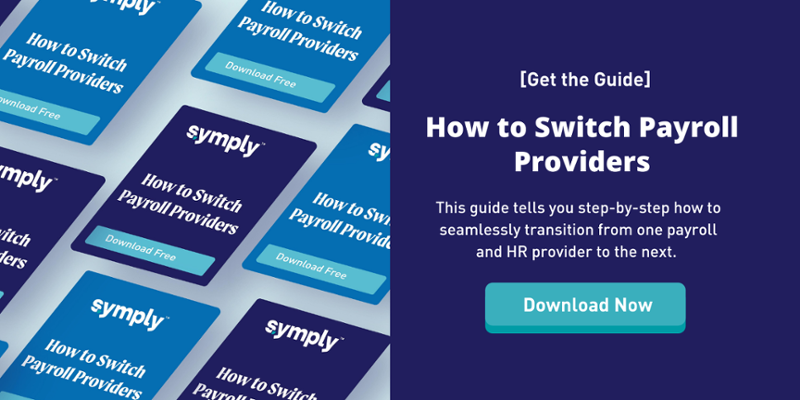HR News & Education
Check out the latest news and resources for small businesses covering topics such as human resources, employee engagement, and management.
How to Switch Payroll Providers

As a small business owner, you've probably put up with inefficient or outdated processes longer than you should (or would like to). Most of the time, identifying the problem isn't the hard part— it's finding the time and resources to research and implement a solution.
When the time comes to upgrade your payroll provider, use this guide to help you budget the time it will take, the information you need to gather, and the steps to follow in order to make a clean switch.
[Free Download] How to Switch Payroll Providers: Guide for Small Business Owners
Key Takeaways
- Evaluate your current provider
- Ask your network for recommendations
- Switch providers the end of the year for a clean break
- Prepare information about your business, employees, and wages that have been paid
- Plan on the transition process to take anywhere from 1-2 days to 1-2 weeks depending on your company size, when you switch, and the provider you choose
- Pay your employees through you new provider on the first payday of the new year
- Give your employees a heads up that you’ve changed payroll providers
How to Switch Payroll Providers
Step 1. Evaluate your current provider
It's safe to assume you've already identified your payroll provider as a problem— Kudos. Now, you need to drill down into why your current provider is a problem before you make the switch.
We've found the best way to analyze your challenges and needs is to list out the features and services your current provider offers and make a note of your experience using each one. This will help establish a baseline of what your company needs and shed light on areas of improvement. Then, make a list of the features and services your current provider lacks.
Step 2. Start shopping
In the age of information, shopping for a new product or service is overwhelming. That's why we suggest doing your evaluation first to help you stay focused.
Larger companies typically have the help of trade shows or brokers to find new products for their business— but as a small business owner, you have to be scrappy.
Basic Google searches will help you discover payroll companies all over the country, and review sites like Yelp, G2, and Capterra are a great source of honest feedback from real clients.
Don't forget to ask around your network for referrals, too. Oftentimes, you can find a company just like yours that has solved a similar problem.
Step 3. Decide when to switch
The best time to change payroll providers is at the end of the year, between the months of October and December. We say this for a few reasons:
- You don't have to transfer historical payroll data to a new provider
- The same company files all of your tax forms
- All of your taxes are more likely to be paid on time
Since payroll involves filing and depositing taxes with various agencies throughout the year, changing providers mid-year can get very messy. For your new provider to file Quarterly Federal Tax Returns, W-2s, and 1099s, you will need to bring over every pay stub for each person paid that year.
But, sometimes, the problem at hand is more extensive, and you can't wait until the end of the year to switch. In that case, the best time to switch is at the end of a quarter. You will still have to bring over all your historical payroll data for the year, but it will make filing your next Quarterly Tax Return much cleaner.
Step 4. Prepare information for your new payroll provider
Most providers will need the following to set up your account:
Company Information
- Federal Employment Identification Number (FEIN)
- Legal business name
- Address (registered with your FEIN)
- Company type
- Banking information (routing and account number)
- State and local tax account information (EDD for California)
- Paystubs or Payroll Journal for every person paid this year (including terminated employees and independent contractors)
Employee Information
- Mailing address
- Social Security Number
- Tax withholding details
Historical Payroll Information (if you switch mid-year)
For complete payroll history, you need to gather the following information for every paycheck for each employee paid in the current year:
- Pay date
- Gross pay
- Federal Income taxes withheld
- FICA/Social Security withheld
- Medicare withheld
- Any state taxes
- Any deductions withheld from the employee (pre-tax, post-tax, and garnishments).
Remember, if you wait until the end of the year to switch, you won't have to bring over historical payroll information (old pay stubs).
If you are switching to Symply, you can set up your account ahead of time for free. We don't bill you until the end of the month after you run your first payroll. Read more about our Account Setup process here.
Step 5. Notify your current provider
Once you have collected the data you need, the time has come to break up with your current provider. Every provider is different, but a 30-day notice is pretty standard (unless your contract says otherwise).
Notify them when your last pay date will be and clarify who is responsible for filing upcoming W2s, 1099s, and Quarterly Returns if necessary.
Now is also an excellent time to ask for any help you need gathering information. If you switch mid-year and need to bring over historical data, your current provider may be able to pull a report with the gross payroll amounts you need (if not, your new provider will!).
Step 6. Transfer information to your new provider
The good news is, you’ve already done a lot of the grunt work just by gathering the information— now, you just need to move it.
The onboarding process (in addition to timing and employee size) has the biggest impact on how long it takes to switch providers.
A self-service onboarding process is quick, easy, and typically cheaper for companies under 50 employees— especially if there is no historical payroll data to bring over.
But, a larger company with complex payroll needs might benefit from a full-service onboarding process to speed things along.
If you are switching to Symply, you can pick which process works best for you. You can also set up your account for free. We don't bill you until the end of the month after you run your first payroll.
Step 7. Schedule your first pay date with your new provider
Scheduling your first pay date could mean marking it on your calendar or submitting it to your new provider, depending on the service you choose. Either way, you’ll need to wrap up your onboarding process before you run your first payroll.
To make a clean switch at the end of the year:
- Run payroll for the last payday of the current year with your OLD provider and;
- Run payroll for the first payday of the new year with your NEW provider
Payroll taxes revolve around when employees are paid, not when they worked. So, even if you pay employees for work they did in December, the wages are reported as income on their W2 for the new year. Schedule your first payday of the year with your new provider to avoid tax filing confusion later down the road.
Step 8. Notify your employees
If you want to keep your employees happy, don't mess with their money. Tell them what to expect on the first payday with your new provider. Paystubs, payday notifications, and payroll processing times can be different with every provider. Giving your employees a heads-up will make the first payday a lot smoother.
Here is what we recommend communicating to your employees:
- Who their payday notifications will come from (if at all)
- How they will receive their paystubs if they are direct deposit or check
- How to access their online employee portal
Step 9. Close your account with your old provider
Many payroll services don't end your account just because you stop running payroll. Some providers charge per payroll, in addition to a base fee. Make sure you cut-off service altogether to avoid unnecessary charges.
Finally, confirm with your old provider how to access your old data once the account is closed. By law, you must retain payroll records for at least three years.

